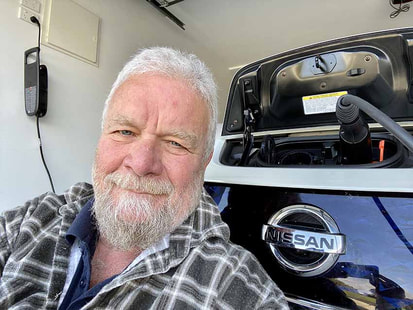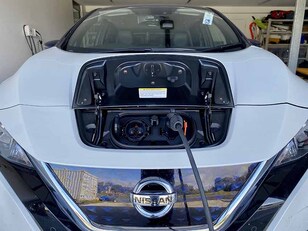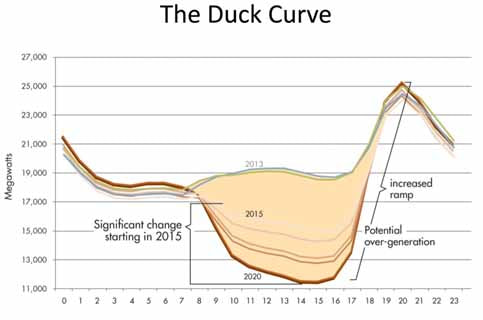 Werner Theinert and the Nissan Leaf e+ ... a car that can
Werner Theinert and the Nissan Leaf e+ ... a car that canpower a house and potentially many other households.
I’VE been working in power stations and the power industry for over 40 years and have always been a fan of solar photo voltaics (Solar PV).
We had a 6 kilowatt system installed in our Callignee home, a 7.5kW system in Wonthaggi and finally a 12kW system here in Harmers Haven. The dream was always to have a battery storage system capable of effectively storing the sun’s excess power during the day and using that stored electrical energy during the evening.
In Harmers Haven we have arranged our Solar Panels such that 4kW are facing east and 8kW are facing west. This has been suggested by the State Government and the NEM to reduce the effects of the “Duck Curve” and the midday Solar PV peak, as too many customers had north facing solar panels.
Background information
The following points and links may assist in understanding what is happening behind your power point and light switch.
- The Tesla Power Wall 2 is capable of storing 13.5kWhrs of electrical energy, which would be enough to run a 2kW electric heater for just over six hours, and would probably cost about $15,000 to install. The aim is to minimise consumption of power from the electricity grid.
- The typical power price of most suppliers is 32 cents/kWhr with a solar feed in tariff (FIT) of approximately 12 cents, with a daily supply charge of $1.14.
- Nissan has developed an all-electric car called a Nissan Leaf, which has a 40kWhr battery installed. This battery has the facility (and Nissan approval) to be connected to a bi-directional charger/inverter arrangement. That means it can be charged during the day and discharged at night. The level of discharge is programmable, to ensure sufficient power is available for the vehicle’s anticipated usage the following day. Consumers in other countries also have the option of a Leaf e+ with a 62kWhr battery. These cars can be imported into Australia from Japan and are called “Grey Imports”
- Amber, a new electricity supplier on the market, supplies electricity to consumers at the wholesale price plus the daily supply charge of 53cents/day with an Amber subscription of $10/month. The wholesale price changes every 30 minutes, and typically is very cheap during the day and can be quite expensive at the peak times between 6pm and 8pm.
- National Electricity Market – Generation types and weekly curves
- AEMO Price/Demand Curves for different states
 Recharging the Nissan Leaf e+
Recharging the Nissan Leaf e+ In the ACT Arena is conducting a trial with 50 Nissan Leafs connected to the grid. These Charger/Inverters are controlled by AEMO (Australian Electricity Market Operator) to assist with the Frequency control of the grid (FCAS), in a cooperative virtual power plant arrangement. The Charger/Inverters receive control signals, similar to the signals being sent to large power plants, to raise and lower their output under preset conditions of price and frequency.
SmartShift trials
Trials are being conducted in South Australia whereby the various loads in the house – hot water, pool pump and battery systems are being automatically controlled to run at times when the price of electricity is low.
The Future – a Virtual Power Plant (VPP)
Ideally if we could charge the battery during the day using either our Solar PV, or cheap electricity due to renewables, and use this electricity in the evening peak between 6pm and 8pm, we could not only save money but could actually make money by feeding into the grid if the Feed in Tariff (FIT) between 6pm and 8pm goes high, due to a possible shortage of supply or high demand on the electricity grid.
In the event of a sudden loss of a major generator or the loss of a major system load, the response of a virtual power plant would be very rapid, as has been demonstrated by Tesla’s Hornsdale Power Reserve (Big Battery) in South Australia. Note : Rapid response to fluctuations in system frequency (50Hz) and voltage is essential, as basically at any instant in time, the power being consumed must be equal to the power being produced. For instance the unscheduled loss of a 500MW Generator from the NEM operating at 20,000MW will cause the frequency to fall rapidly. This requires rapid replacement of that 500MW by all the machines connected to the grid at that particular time.
Imagine a future where one million customers in Eastern Australia who all have their electric vehicles connected to the virtual grid and are each capable of importing or exporting 5kW of power at a moment’s notice. That would mean a potential reserve of five Gigawatts, which is equivalent to the combined outputs of Yallourn, Loy Yang A and Loy Yang B power stations in Victoria. Certainly much bigger than any Snowy 2.0.
Of course not all cars will be connected at all times to their home charger/inverters, because some cars would be in transit or parked at work. Theoretically the carpark at work could also have a charger/inverter, with the owner plugged into the charge point and logged into his own electricity account.
Does this sound too far-fetched? We currently have the ability to move money into and out of our accounts via electronic funds transfer, we can remove or credit funds via a credit card and we can make withdrawals from any ATM. Why can’t we do banking with kilowatts as we do with dollars?
I have recently changed electricity suppliers to Amber and purchased a Nissan Leaf e+. and am now waiting for the completion of the V2G trials in the ACT and the SMARTSHIFT trials in South Australia. Hopefully this will result in the approval of the bi-directional charger/inverter hardware and software to make this vision a reality.
